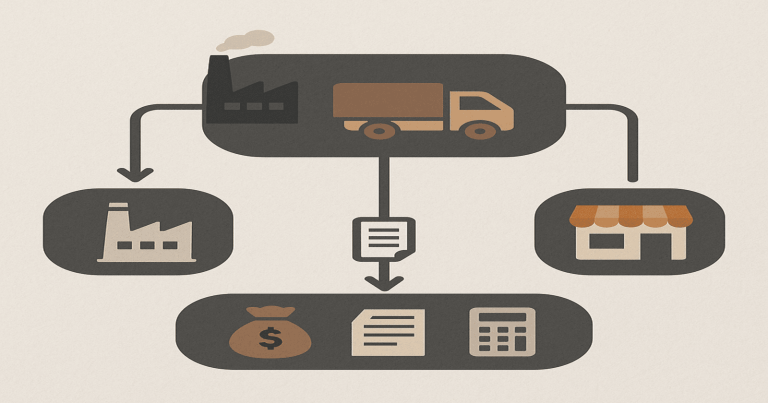Business is all around us — from a local grocery store to large multinational companies like Reliance or Infosys. Every product we use and every service we consume is the result of multiple processes carried out by businesses. These processes include producing goods, managing workers, transporting materials, promoting products, handling money, and finally, delivering the product or service to the customer. All these efforts together are known as business activities. Every activity has a specific role and purpose in helping the business run smoothly and earn profits. To understand how businesses function efficiently, we need to classify these activities in a structured way. Business activities are mainly classified into three financial categories: operating, investing, and financing. They can also be classified functionally as industry and commerce, which helps us understand the flow from production to distribution. These classifications not only help businesses track performance but also assist students, professionals, and policymakers in understanding how the economy functions.
What is Business?
Business is an economic activity that involves producing, selling, or distributing goods and services with the aim of earning profit. It requires regular operations, involves risks, and satisfies human wants. From a small tea stall to a multinational IT company, all are examples of business.
Business is not just about selling something — it includes every effort that goes into planning, producing, promoting, and delivering a product or service. A successful business understands customer needs and ensures goods or services reach them efficiently.
Key Features of Business:
- Economic activity for profit
- Involves regular transactions
- Needs investment and planning
- Carries risk and uncertainty
- Focuses on satisfying consumer needs
What Do You Mean by Business Activities?
Business activities refer to all the economic actions that a business performs to carry out its main goal — which is to make a profit. These include buying raw materials, manufacturing, delivering products, investing in assets, raising funds, and paying workers.
All such activities, whether day-to-day transactions or long-term investment decisions, are business activities. They are systematic, goal-oriented, and closely tracked in accounting records.
Why are Business Activities Important?
- They help businesses grow and earn.
- They support decision-making and planning.
- They show how a business operates financially.
- They help stakeholders assess performance.
Every business activity is either helping in daily operations, generating income for the future, or managing capital and cash.

How Would You Classify Business Activities?
Business activities can be classified in two distinct ways, depending on purpose and function:
- On the basis of financial nature (as per accounting/cash flow)
- On the basis of functional structure (industry and commerce)
Let’s explore both classifications in detail.
1. Classification Based on Financial Nature
This method is used in accounting and financial reporting, especially in cash flow analysis. It classifies business activities into:
A. Operating Activities
Operating activities are the main day-to-day business functions that relate directly to the company’s core business operations. These include all transactions involved in producing goods or delivering services, as well as earning revenue.
These are the ones that directly affect profit-loss statements. Examples include cash received from customers, payments to suppliers, wages to employees, rent payments, and taxes.
For example, in a textile business where manufacturing and selling garments involves paying salaries and customer payments will be termed as operating activities.
B. Investing Activities
Investing activities involve the acquisition and disposal of long-term assets and other investments not included in cash equivalents. These activities show how a business uses its money to generate future income.
Such transactions usually appear on the cash flow statement and do not occur regularly like operating activities. Examples include purchasing or selling property, plant and equipment or investing in shares or bonds of other companies.
Example:
If an electronics company buys a new factory machine, it is an investing activity because the machine will help in production for many years.
C. Financing Activities
The definition of financing activities is that they affect changes in the amount and/or structure of the capital of an enterprise. These activities comprise raising or repaying funds, thus affecting the balance sheet and cash flow statement.
Financing mainly includes the issuance of shares, acquiring loans, repaying debts, and declaring dividends to shareholders.
Example:
When a company takes a bank loan or issues new equity to fund expansion, it is engaging in financing activities.
2. Classification Based on Functional Structure
When we classify business activities based on what function they serve in the economy, we get a traditional yet highly practical framework used in commerce and economics. This classification divides business activities into two broad categories:
- Industry
- Commerce
This structure focuses on how goods and services are produced, distributed, and delivered to the end consumer. Let’s understand each part in full detail:
1. Industry
An industry includes all those business activities that are involved in the conversion of raw materials into finished goods or that provide useful services. Industry is the starting point of all business activity. It contributes directly to the creation of products that can be sold to generate revenue.
Industries deal with production, and production may involve extraction from nature, processing raw materials, manufacturing finished goods, or even providing intangible services.
Types of Industry:
a) Primary Industry:
This industry extracts or harvests natural resources from the Earth. It forms the base for all other types of industries, as raw materials are necessary for manufacturing.
- Examples: Agriculture, fishing, mining, forestry, oil drilling
- Real-life scenario: A farmer growing wheat or a company extracting iron ore from the earth
b) Secondary Industry:
This industry uses the raw materials supplied by primary industries to manufacture finished goods. It includes both small-scale and large-scale manufacturing units.
- Examples: Textile mills (cotton to clothes), bakeries (flour to bread), automobile factories
- Real-life scenario: A factory converting crude oil into petrol
c) Tertiary Industry:
This industry does not produce goods but provides essential services that support both primary and secondary industries, as well as consumers.
- Examples: Transport, communication, banking, insurance, warehousing
- Real-life scenario: A courier company delivering finished goods to customers
These three layers of industry often work together to complete the product journey. For example, iron ore (primary) is turned into steel (secondary), and the steel is sold using transport and advertising (tertiary).
2. Commerce
Commerce is the second main classification under the functional structure. While industry deals with making goods, commerce takes care of making those goods available to consumers. Commerce includes all those activities that are necessary to move goods from the place of production to the place of consumption.
It ensures the flow of goods and services in the market and helps bridge the gap between producers and consumers. Commerce includes trade, and the various aids to trade that make buying and selling smoother.
Components of Commerce:
a) Trade
Trade refers to the buying and selling of goods and services with the motive of earning profit. It is the most visible aspect of commerce and happens in two ways:
- Internal Trade (Domestic Trade):
- Trade within the borders of a country.
- It can be wholesale (buying in bulk from manufacturers and selling to retailers) or retail (selling directly to consumers).
- Example: A retailer in Delhi buying rice from a wholesaler in Punjab.
- External Trade (International Trade):
Trade is vital because it creates markets, allows price discovery, and helps producers reach buyers efficiently.
b) Aids to Trade
Trade cannot happen without certain supporting services. These services are known as aids to trade, and they ensure that goods move smoothly, securely, and successfully through the system. These include:
1. Banking
Provides the financial support businesses need to operate. Banks offer:
- Working capital loans
- Trade finance
- Payment gateways
2. Insurance
Protects businesses against various risks such as theft, fire, transit damage, or natural disasters.
3. Transportation
Moves raw materials to factories and finished goods to markets. It includes:
- Road transport
- Railways
- Airways
- Shipping
4. Warehousing
Stores goods safely until they are needed. Helps maintain stock during off-season or bulk purchases.
5. Advertising
Creates product awareness, builds brand image, and attracts customers. Includes TV, radio, digital, print, etc.
6. Communication
Ensures timely exchange of information between producers, sellers, and consumers. In the modern day, email, mobile, and instant messaging are crucial.
Together, these aids make commerce efficient, reliable, and profitable. They enable large-scale trade by solving problems of distance, time, money, and risk.
Interrelationship Between Industry, Trade, and Commerce
Interplay among industry, trade, and commerce is required for the effective functioning of any business. These three concepts are interdependent and form the very foundation of any economy.
1. Industry Creates Goods
Without industry, there would be no goods to sell. Industries use natural resources or raw materials and convert them into usable products through manufacturing and processing.
For example, the textile industry converts cotton into cloth — this is production, which is the basis of all commerce and trade.
2. Commerce Distributes Goods
Once goods are produced, they need to reach consumers. This is done through commerce, which involves buying, selling, transporting, and storing goods. Commerce ensures that what is produced is made available in the right place at the right time.
3. Trade Sells Goods
Trade is a part of commerce and involves the actual exchange of goods. Traders buy goods from manufacturers (wholesalers) and sell them to retailers or directly to consumers.
How They Work Together:
- A factory (Industry) makes electric fans.
- The fans are transported to a warehouse (Commerce).
- A shopkeeper buys from a wholesaler and sells to customers (Trade).
If any one part fails, the chain breaks — production is wasted, customers are dissatisfied, and businesses lose money. Hence, a strong interrelationship is essential for smooth economic activity.
Classification of Business Activities FAQs
1. What are the three main types of business activities?
Operating, investing, and financing activities — based on business function and purpose.
2. What is the difference between trade and commerce?
Trade is the act of buying and selling goods. Commerce includes trade and all supporting services like banking, transport, and advertising.
3. What is an example of an investing activity?
Buying machinery or investing in company shares for long-term benefit.
4. How are industry and commerce related?
Industry produces goods, and commerce ensures their distribution to consumers.
5. What are aids to trade?
Banking, insurance, warehousing, transport, advertising, and communication — all of which support the smooth flow of trade.


